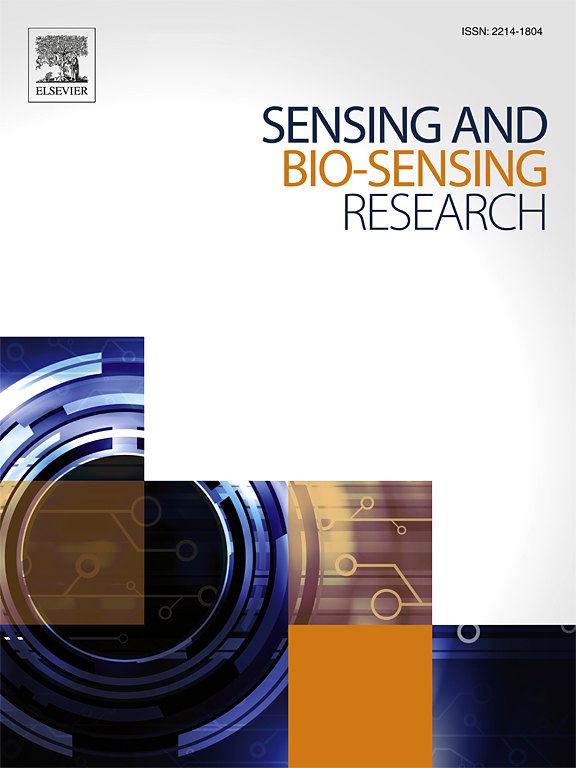Telluride quantum dot-amplified immunosensor for interferon gamma – A TB antigen test biomarker
IF 4.9
Q1 CHEMISTRY, ANALYTICAL
引用次数: 0
Abstract
Interferon-gamma (IFN-γ) is a cytokine (i.e. a microprotein involved in cell signaling and immunomodulation) which is known to be expressed in response to Mycobacterium tuberculosis (Mtb) infections. For this reason, IFN-γ has gained prominence as a diagnostic biomarker for TB antigen tests, such as Interferon-Gamma Release Assays (IGRAs). Recent research efforts have focused on improving the sensitivity of TB tests based on IFN-γ. In this study, a new and sensitive chalcogenide-based electrochemical IFN-γ immunosensor was developed. The chalcogenide is a 9.30 nm average diameter bimetallic copper zinc telluride (CuZnTe) quantum dot (QD) particles, which were stabilised by sequential triple-capping with thioglycolic acid (TGA), (3-mercaptopropyl)trimethoxysilane (MPS) and tetraethylorthosilicate (TEOS) (i.e. CuZnTe-TGA-MPS-TEOS QD). The morphologies of the quantum dots were determined by X-ray transmission electron microscopy (TEM) and small angle X-ray scattering spectroscopy (SAXS); while their structural characteristics were ascertained with Raman and X-ray diffraction (XRD) spectroscopic analyses. A gold disk electrode (AuE) surface was functionalized with CuZnTe-TGA-MPS-TEOS QD, anti-interferon-gamma antibody (Anti) and bovine serum albumin (BSA) to create a BSA/Anti/CuZnTe-TGA-MPS-TEOS QD/AuE amperometric immunosensor bioelectrode. The immunosensor exhibited a linear detection range (LDR) value of 2–20 pg/mL IFN-γ, a limit of detection (LOD) value of 0.82 pg/mL IFN-γ and was highly sensitive in human serum samples with recovery rates of 97–99 %.
干扰素γ - A结核抗原检测生物标志物的碲化物量子点扩增免疫传感器
干扰素-γ (IFN-γ)是一种细胞因子(即参与细胞信号传导和免疫调节的微蛋白),已知在对结核分枝杆菌(Mtb)感染的反应中表达。因此,IFN-γ作为结核抗原检测(如干扰素-γ释放试验(IGRAs))的诊断性生物标志物已获得突出地位。最近的研究工作集中在提高基于IFN-γ的结核病检测的敏感性上。在这项研究中,开发了一种新的、灵敏的基于硫族化合物的电化学IFN-γ免疫传感器。硫系化合物是平均直径为9.30 nm的双金属碲化铜锌(CuZnTe)量子点(QD)粒子,通过巯基乙酸(TGA)、(3-巯基丙基)三甲氧基硅烷(MPS)和四乙基硅酸(TEOS)连续三重盖层(即CuZnTe-TGA-MPS-TEOS QD)对其进行了稳定。利用x射线透射电子显微镜(TEM)和小角x射线散射光谱(SAXS)对量子点的形貌进行了表征;通过拉曼光谱和x射线衍射(XRD)光谱分析确定了它们的结构特征。将CuZnTe-TGA-MPS-TEOS QD、抗干扰素γ抗体(Anti)和牛血清白蛋白(BSA)功能化在金圆盘电极(AuE)表面,构建了BSA/Anti/CuZnTe-TGA-MPS-TEOS QD/AuE安培免疫传感器生物电极。该免疫传感器的线性检测范围(LDR)为2 ~ 20 pg/mL IFN-γ,检出限(LOD)为0.82 pg/mL IFN-γ,对人血清样品高度敏感,回收率为97 ~ 99%。
本文章由计算机程序翻译,如有差异,请以英文原文为准。
求助全文
约1分钟内获得全文
求助全文
来源期刊

Sensing and Bio-Sensing Research
Engineering-Electrical and Electronic Engineering
CiteScore
10.70
自引率
3.80%
发文量
68
审稿时长
87 days
期刊介绍:
Sensing and Bio-Sensing Research is an open access journal dedicated to the research, design, development, and application of bio-sensing and sensing technologies. The editors will accept research papers, reviews, field trials, and validation studies that are of significant relevance. These submissions should describe new concepts, enhance understanding of the field, or offer insights into the practical application, manufacturing, and commercialization of bio-sensing and sensing technologies.
The journal covers a wide range of topics, including sensing principles and mechanisms, new materials development for transducers and recognition components, fabrication technology, and various types of sensors such as optical, electrochemical, mass-sensitive, gas, biosensors, and more. It also includes environmental, process control, and biomedical applications, signal processing, chemometrics, optoelectronic, mechanical, thermal, and magnetic sensors, as well as interface electronics. Additionally, it covers sensor systems and applications, µTAS (Micro Total Analysis Systems), development of solid-state devices for transducing physical signals, and analytical devices incorporating biological materials.
 求助内容:
求助内容: 应助结果提醒方式:
应助结果提醒方式:


